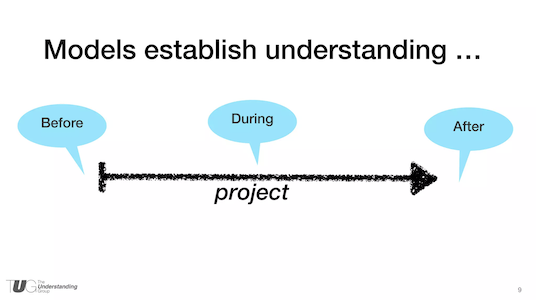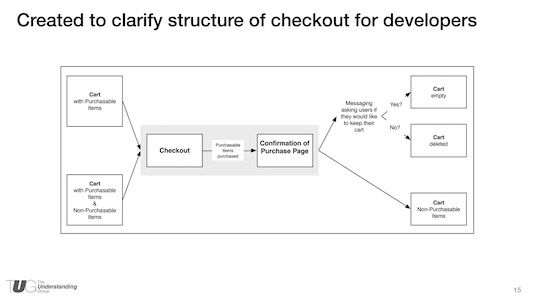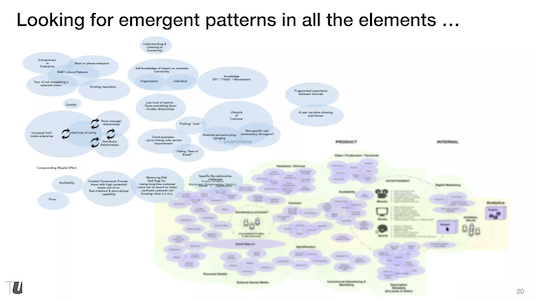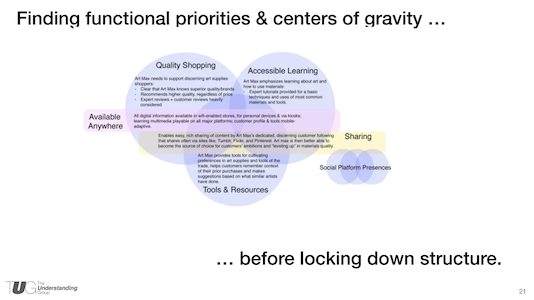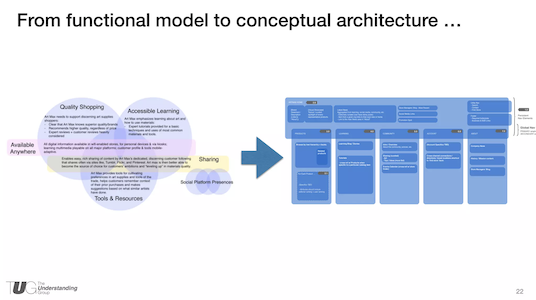Summary: Dan Klyn and Abby Covert speak on working out problems of form, structure, and meaning in user experience, expressed as "form follows forces."
Below is the full text of the first part of the joint keynote presentation that Abby Covert and I gave at World IA Day in Ann Arbor in February of 2014.
Last year at World IA Day NYC, my co-presenter Abby Covert conducted an on-stage interview with Lou Rosenfeld about the history of information architecture, and Lou prefaced his comments with an observation that I’d like to re-iterate here in Ann Arbor today.
We’re living and working in extraordinary times, akin to those of the beginning of the Industrial Revolution.
We’re living in the midst of a change in human culture as monumental as that of the Industrial Revolution. When viewed from the timescale of history, we’re still in the first few hours of the first day of a new era.
And as was the case at the beginning of the Industrial Revolution, the ways of the “old” world and the ways of the “new” world are all smeared together. Horses and cars at the same time.
I made this observation to my friend Hassan Hodges a few weeks ago, and he told me to look up the “horsey horseless.”
This is us now—fumbling for forms for the things we make that work in the actual world. In a world where the horses get scared by the cars.
It’s normal and natural and ok that most everything we’ve made in our infancy with these new media from the “new” world are goofy things that don’t really work.
But I don’t want to make goofy things forever. I want to get beyond horsey horseless. But how do you do that? How do you get to forms that work for the new world without re-creating the problems of the old one?
Denise Scott Brown has observed that “faced with the unmeasurable, people steer their way by magic.”
I don’t believe in magic. So one of the ways I’ve navigated all this is to look to and follow a figurehead—someone who’s seemed to master the unmeasurable, and who’s done and doing good work. What would they do?
What would Richard Saul Wurman do?
“It’s not enough in this moment in fast-moving history to make just a better version of what has happened before… its going to work for a while, so it’s going to fool people… but nothing goes on forever—they’re going to have to go backwards to find some new beginnings to branch out from.”
Just an improved version of what came before isn’t enough. Mr. Wurman recommends that we go backward to find new beginnings. Back to a place before the pre-conceptions about structure and meaning that are operative in web design and user experience today.
I had my graduate students doing this last fall in SI658, looking back at the ways people have thought about and practiced architecture in the built environment and digging into how it came to be that movements like beaux-arts provided a way for designers to know how form and structure and meaning ought to be worked out.
With modernism, the guidance for working out problems of form and structure and meaning is stated as a maxim: form follows function.
This is the Glass House by Philip Johnson, and part of why the form of this structure is able to be so pleasing is because the functional requirements here have been simplified to the point of nonexistence.
Nobody lives in this house. Its not for living, it’s for photographing, and for the paying of homage to Mies van de Rohe, whose maxim was “less is more.”
Form follows function works best when function is hyper-simplified. Like Pinterest. Modernist approaches to structural form are appealing because everything is in its right place.
The reaction to modernism’s strict rules for selecting a structural form and working out its relation to function and meaning is called postmodernism—where form *flouts* function. In contrast with modernism’s “everything in its place” this is “whatever, all over the place.”
In between the strictness of “everything in its place” modernism and “everything all over the place” postmodernism is a weird micro-movement called mannerism. The mannerist maxim is “less is a bore.” Its approach to balancing form and meaning and function is through an embrace of human complexity and contradiction.
This is the Sanisbury wing of the National Gallery in London, on Trafalgar Square—a triumph of mannerist architecture and place-making by the American architects Venturi and Scott Brown.
Venturi and Scott Brown’s mannerism isn’t an architecture of perfection like modernism, nor an architecture that denies the possibility of universal guiding principles, like postmodernism. The highest praise for or from a mannerist in the tradition of Venturi and Scott Brown would be to say that the work is “almost all right.”
The Sainsbury wing is almost all right because it fits into its context on Trafalgar Square. In an almost seamless way. But it’s not seamless. It’s seamful. When you notice what the building is doing, that’s on purpose. There’s meaning in the breaks in the order, and also in the places where the order is not broken.
From the square, the facade of the Sainsbury wing appears to be of a piece with the beaux-arts structure of the main museum. Blends right in.
But then in this stairwell, which is mostly occluded from view on the square, the beaux-arts gives way to high modernism.
And even out on the square, where your first glance assessment is that these buildings are of a piece, and maybe even built at the same time, with a second, closer look you might notice these delightfully colored Egyptian-styled capitals atop the pillars that operate the iron gates that swing into place when the museum is closed. The collision of these three architectural styles and systems of meaning is skillfully balanced by the architects, but never perfectly resolved.
Abby and I quite like mannerism, and the best example in digital space of this almost all right—inconsistent at times and on purpose way of working out form and meaning is Medium, from the makers of blogger.
Medium is a new place on the Internet where people share ideas and stories that are longer than 140 characters and not just for friends. It’s designed for little stories that make your day better and manifestos that change the world.
Turns out, Medium doesn’t let you edit or write these little stories and manifestos on a mobile phone.
On a tablet or PC, fine. But not on mobile. Not because you can’t. Not because offering that functionality is hard or expensive or takes a long time. But because they think you ought not.
They’ve chosen forms for their product’s various expressions that are inconsistent at times and on purpose. Because of reasons. The breaks in the order mean something—teach you something about the service. These forms are almost all right. And they follow the operative forces.

















